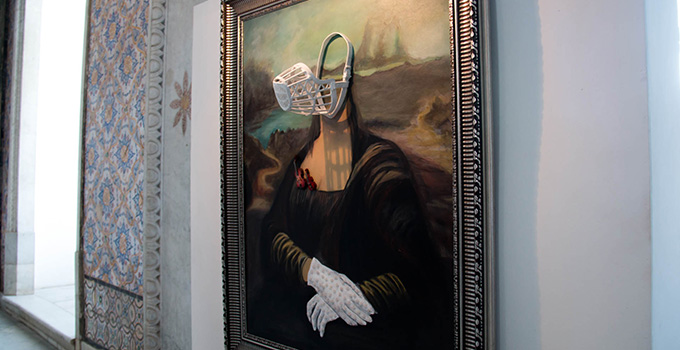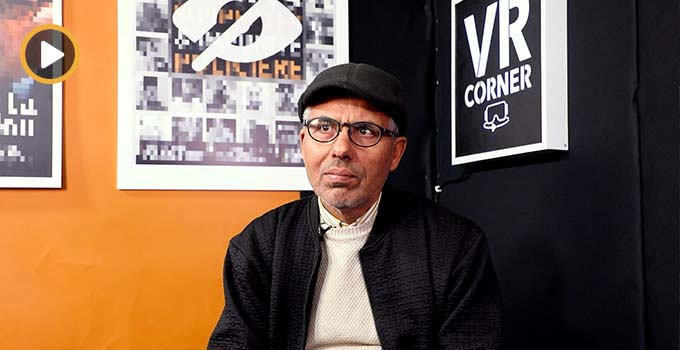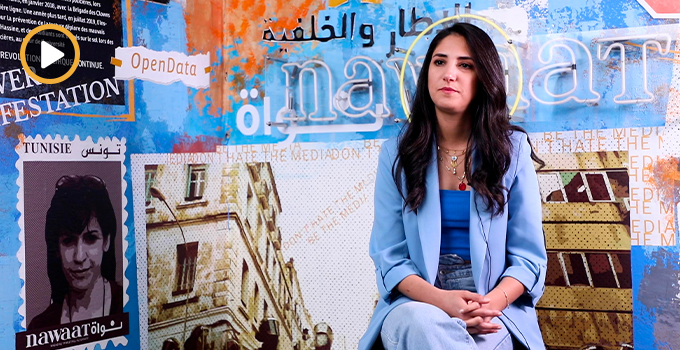Days before Spring break, a group of elementary school students have poured into the Museum’s Great Hall. Without batting an eye, each one pulls out a smartphone and flicks it on to camera mode, only then seeming to take notice of the enormous bust which occupies the main hall of the building. The 16-foot high sculpture, a headless torso wearing a white-collar shirt and muzzle, is the Barker [« l’Aboyeur » in French], a fictional character created by plastic artist Faten Rouissi. The faceless figure which greets visitors as they walk into the Museum is one of more than 15 representations of the imagined character who symbolizes the omnipresence and clamor of mainstream media in Tunisia following the revolution.

Failures and muzzles
At the Driba, an arched, low-light corridor attached to the Great Hall, Moune Djebby is artistic guide for the exhibition. Djebby, who has just finished a degree in cultural mediation, takes visitors on a tour through the life of the Barker, from birth through adulthood. In each of the alcoves which line the walls of the hallway, the Barker is portrayed in his various forms and through different mediums: painted, sculpted, molded, filmed and electrified. Djebby stops before each Barker, who, in spite of multiple transformations, is always recognizable in his signature button-up shirt and muzzle. She explains: « After the revolution, on TV, in cafés, everywhere people wanted to give their opinion on anything and everything, even if it wasn’t interesting, just to be noticed. The idea of the muzzle, which of course is used for dogs, is not to silence people, but to teach them to think before speaking ».

Pausing next to « The Barker and the Intellect », a 3D portrait of the protagonist beside a figure in a button-up shirt and with a poetry book in the place of a head, Djebby describes how the Barker « always wants to rub shoulders with intellectuals ». She explains that « the Barker himself is not intelligent. His mind is empty, but he never stops making noise ». At some point in his life, the Barker encounters the Dreamer, a limbless and headless figure in a white dress whose collar is flush with flowers. « But », Djebby remarks, « the Barker fails to seduce her because, unlike the Dreamer who is full of new ideas, he is stagnant and cannot evolve. He is a consumer of information who does not listen or receive: he only emits information without reflection ».

Beyond the Driba, the Barker finds a niche in several strategic locations throughout the Museum. Djebby leads us to the second floor, where the astounding Carthage Room houses Roman statues and portraits from the 1st-3rd centuries AD. Towards the far end of the room, at the foot of three life-size statues and marble columns is a glowing, foot-high sculpture of the Barker. Side-stepping the mosaic underfoot, we approach the « Party-animal Barker »: his standard attire is lined with a tube of white lights, and muzzle with a coiled tube of blue lights, an almost comical contrast with the surrounding architecture and sculptures.
From El Jem to Bardo through Vienna
After a walk-through with Djebby, we find the artist, Faten Rouissi, back downstairs in the Driba. As she tweaks the installation and fixes lights on « The Chameleon Barker », Rouissi delves into how and why she conceived this person, « at once real and unreal. I’ve created this character, this story, which is inspired by everday life, by a young democracy, or by all democracies. It’s a phenomenon that exists everywhere and in all eras… »
Rouissi describes how the Barker « is born of the mediums of today, but there is an entire national heritage that he wants to meet, so he seeks out strategic places, the most important places in Tunisia ». Indeed, the Barker made his first appearance in a live performance at El Jem (Mahdia), a UNESCO heritage site and one of the world’s largest Roman ampitheaters. « He made his way to the Opera Ball Orchestra of Vienna where he was mute, he danced, he was present in all of his splendor » recounts Rouissi. Afterwards, the artist explains that she was contacted by the Agency for the Development of National Heritage and Cultural Promotion (AMVPPC), and in collaboration with the National Heritage Institute (INP) they brought the Barker to the Bardo Museum, « because it fits in with the philosophy of how contemporary art can dialogue with history, even with ancestral Roman and Punic architecture. Here, for example, the Barker finds his place in the Carthage Room—he could not find better than this space so full of history… ».

Rouissi says that the idea is « to make people reflect », and between the social-political commentary and historical contrast that it presents, the Barker at Bardo accomplishes as much. If in this sense the exposition satisfies its role as a contemporary art installation, the message it conveys is, at least to some degree, diluted through repetition. For although the character is portrayed through a gamut of artistic mediums and in various forms—painted in the likeness of Mona Lisa in « Lisa the Barker », or posing for a mosaicked selfie with the Roman poet Virgil in « The Barker and Virgil », his numerous manifestations turn around the same ideas without necessarily elaborating on them, to the extent that they reproduce clichés of the original concept. This redundancy is more or less counterbalanced by the project’s interactive aspects— periodic live performances (which took place during the exhibition’s opening night on March 10), and dialogue with the artistic guide throughout the exposition. Rouissi herself mentions that « human contact » is vital to the project, which one can imagine will be replicated after the Bardo Museum, since the Barker is always ready to « pack his bags and travel elsewhere. He could even head to the other side of the Mediterranean ».





iThere are no comments
Add yours